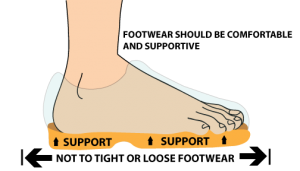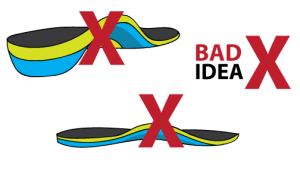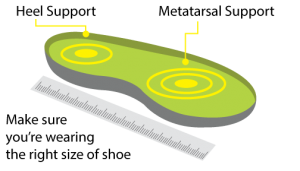What is “Proper Footwear”?
When it comes to treatments for Plantar Fasciitis, one of the top recommendations is proper footwear…but what does this mean? First of all, not everyone with Plantar Fasciitis will have the same needs when it comes to footwear, but something that everyone should do is ensure that their footwear actually fits. Shoes that are too tight or too loose will only make your problem worse, and could actually be the cause of your Plantar Fasciitis. Essentially, proper footwear consists of strong support for your heel and metatarsals. You should also avoid high heels and any footwear that has an open back.
needs when it comes to footwear, but something that everyone should do is ensure that their footwear actually fits. Shoes that are too tight or too loose will only make your problem worse, and could actually be the cause of your Plantar Fasciitis. Essentially, proper footwear consists of strong support for your heel and metatarsals. You should also avoid high heels and any footwear that has an open back.
What You Do Need
- Heel Support
Proper heel support is important for people with Plantar Fasciitis, as it helps absorb the pressure of your footfalls. Try to look for footwear with extra heel support to help relieve your pain.
Support of the metatarsals (the balls of your feet) is another thing to look for in footwear. Like with heel support, metatarsal support will alleviate some of the strain associated with walking and standing.
- Shoes That FIT
As mentioned above, shoes that actually fit are extremely important. If your shoes give you blisters on the back of your ankle or squeeze your toes, this is a sign that they do not fit properly. Your shoes also shouldn’t apply too much pressure to the top of your feet while you’re wearing them.
What You Don’t Need
- Orthotic Inserts
Many people who suffer from Plantar Fasciitis get orthotic inserts to help relieve the pain and provide support for their foot. However, orthotics should not be worn for prolonge d periods of time as they can actually cause harm and do not address the underlying issue causing your Plantar Fasciitis.
d periods of time as they can actually cause harm and do not address the underlying issue causing your Plantar Fasciitis.
- Arch Support
Contrary to popular belief, arch support is unnecessary and can be harmful to your feet if used for extended periods of time. You want to avoid any extra force being applied to your plantar fascia when recovering from Plantar Fasciitis, as this can cause more injury and more pain.
